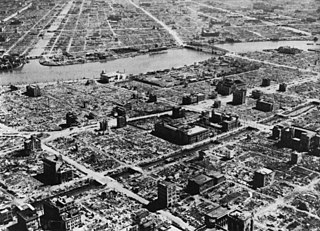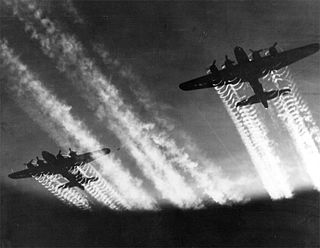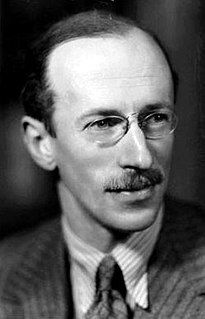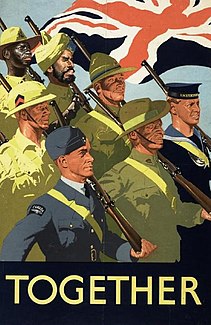Related Research Articles

Blitzkrieg is a method of warfare where the attacker, spearheaded using a force concentration of armoured and motorised or mechanised infantry formations with close air support, breaks through the opponent's line of defence by short, fast, powerful attacks and then dislocates the defenders, using speed and surprise to encircle them with the help of air superiority. Through the employment of combined arms in manoeuvre warfare, blitzkrieg attempts to unbalance the enemy by making it difficult for it to respond to the continuously changing front, then defeat it in a decisive Vernichtungsschlacht.
Asymmetric warfare is war between belligerents whose relative military power differs significantly, or whose strategy or tactics differ significantly. This is typically a war between a standing, professional army and an insurgency or resistance movement militias who often have status of unlawful combatants.

Strategic bombing is a military strategy used in total war with the goal of defeating the enemy by destroying its morale, its economic ability to produce and transport materiel to the theatres of military operations, or both. It is a systematically organized and executed attack from the air which can utilize strategic bombers, long- or medium-range missiles, or nuclear-armed fighter-bomber aircraft to attack targets deemed vital to the enemy's war-making capability.
Military strategy is a set of ideas implemented by military organizations to pursue desired strategic goals. Derived from the Greek word strategos, the term strategy, when it appeared in use during the 18th century, was seen in its narrow sense as the "art of the general", or "'the art of arrangement" of troops. Military strategy deals with the planning and conduct of campaigns, the movement and disposition of forces, and the deception of the enemy.

Albert Kesselring was a German Generalfeldmarschall of the Luftwaffe during World War II who was subsequently convicted of war crimes. In a military career that spanned both world wars, Kesselring became one of Nazi Germany's most highly decorated commanders, being one of only 27 soldiers awarded the Knight's Cross of the Iron Cross with Oak Leaves, Swords and Diamonds.

The military history of the United Kingdom in World War II covers the Second World War against the Axis powers, starting on 3 September 1939 when Britain and France, followed by most of Britain's Dominions and Crown colonies, declared war on Nazi Germany in response to the invasion of Poland by Germany. Winston Churchill became prime minister and head of a coalition government in May 1940. Despite the defeat of its European allies and the British Expeditionary Force in the first year of the war leading to the Dunkirk evacuation, Britain and its Empire continued the fight alone against Germany. Churchill engaged industry, scientists and engineers to advise and support the government and the military in the prosecution of the war effort. Germany's planned invasion of the UK was averted by its failure to establish air superiority in the Battle of Britain, and by its marked inferiority in naval power. Subsequently, urban areas in Britain suffered heavy bombing during the Blitz in late 1940 and early 1941.

A strategic bomber is a medium- to long-range penetration bomber aircraft designed to drop large amounts of air-to-ground weaponry onto a distant target for the purposes of debilitating the enemy's capacity to wage war. Unlike tactical bombers, penetrators, fighter-bombers, and attack aircraft, which are used in air interdiction operations to attack enemy combatants and military equipment, strategic bombers are designed to fly into enemy territory to destroy strategic targets. In addition to strategic bombing, strategic bombers can be used for tactical missions. There are currently only three countries that operate strategic bombers: the United States, Russia and China.
Attrition warfare is a military strategy consisting of belligerent attempts to win a war by wearing down the enemy to the point of collapse through continuous losses in personnel and material. The war will usually be won by the side with greater such resources. The word attrition comes from the Latin root atterere to rub against, similar to the "grinding down" of the opponent's forces in attrition warfare.

In military tactics, close air support (CAS) is defined as air action such as air strikes by fixed or rotary-winged aircraft against hostile targets that are in proximity to friendly forces and which requires detailed integration of each air mission with fire and movement of these forces and attacks with aerial bombs, glide bombs, missiles, rockets, aircraft cannons, machine guns, and even directed-energy weapons such as lasers.
The History of the Second World War is the official history of the British contribution to the Second World War and was published by Her Majesty's Stationery Office (HMSO). The immense project was sub-divided into areas to ease publication, United Kingdom Military Series, the United Kingdom Civil Series for the civilian war effort; the Foreign Policy series, the Intelligence series and the Medical series are eponymous. Other volumes not under the aegis of the series but published by HMSO may be read as adjuncts, covering matters not considered in great detail or at all, in one case, in the main series. Further volumes, published after the privatisation of HMSO or in the series about the Special Operations Executive, are also useful.

The Battle for Caen is the name given to fighting between the British Second Army and the German Panzergruppe West in the Second World War for control of the city of Caen and vicinity, during the larger Battle of Normandy. The battles followed Operation Neptune, the Allied landings on the French coast on 6 June 1944 (D-Day). Caen is about 9 mi (14 km) inland from the Calvados coast astride the Orne River and Caen Canal, at the junction of several roads and railways. The communication links made it an important operational objective for both sides. Caen and the area to the south is flatter and more open than the bocage country in western Normandy; Allied air force commanders wanted the area captured quickly to base more aircraft in France.

The military history of the United States in World War II covers the war against the Axis powers, starting with the 7 December 1941 attack on Pearl Harbor. During the first two years of World War II, the United States had maintained formal neutrality as made official in the Quarantine Speech delivered by U.S. President Franklin D. Roosevelt in 1937, while supplying Britain, the Soviet Union, and China with war material through the Lend-Lease Act which was signed into law on 11 March 1941, as well as deploying the U.S. military to replace the British forces stationed in Iceland. Following the "Greer incident" Roosevelt publicly confirmed the "shoot on sight" order on 11 September 1941, effectively declaring naval war on Germany and Italy in the Battle of the Atlantic. In the Pacific Theater, there was unofficial early U.S. combat activity such as the Flying Tigers.
Force concentration is the practice of concentrating a military force so as to bring to bear such overwhelming force against a portion of an enemy force that the disparity between the two forces alone acts as a force multiplier in favour of the concentrated forces.

Sir Basil Henry Liddell Hart, commonly known throughout most of his career as Captain B. H. Liddell Hart, was a British soldier, military historian and military theorist. In the 1920s and later he wrote a series of military histories that proved influential among strategists. He argued that frontal assault was a strategy that was bound to fail at great cost in lives, as happened in the First World War. He instead recommended the "indirect approach" and reliance on fast-moving armoured formations.

When the United Kingdom declared war on Nazi Germany at the outset of World War II it controlled to varying degrees numerous crown colonies, protectorates and the Indian Empire. It also maintained unique political ties to four semi-independent Dominions—Australia, Canada, South Africa, and New Zealand—as part of the Commonwealth. In 1939 the British Empire was a global power, with direct or de facto political and economic control of 25% of the world's population, and 30% of its land mass.

The Mediterranean Allied Air Forces (MAAF) was the major Allied air force command organization in the Mediterranean theater from mid-December 1943 until the end of the Second World War.

The air warfare of World War II was a major component in all theaters of the war and, together with anti-aircraft warfare, consumed a large fraction of the industrial output of the major powers. Germany and Japan depended on air forces that were closely integrated with land and naval forces; the Axis powers downplayed the advantage of fleets of strategic bombers, and were late in appreciating the need to defend against Allied strategic bombing. By contrast, Britain and the United States took an approach that greatly emphasised strategic bombing, and tactical control of the battlefield by air, as well as adequate air defences. Both Britain and the U.S. built a substantially larger strategic forces of large, long-range bombers. Simultaneously, they built tactical air forces that could win air superiority over the battlefields, thereby giving vital assistance to ground troops. The U.S. and Royal Navy also built a powerful naval-air component based on aircraft carriers, as did the Japanese; these played the central role in the war at sea.

Clearing the Channel Coast was a World War II task undertaken by the First Canadian Army in August 1944, following the Allied Operation Overlord and the victory, break-out and pursuit from Normandy.
Heinz Greiner was a German general in the Wehrmacht during World War II. He was a recipient of the Knight's Cross of the Iron Cross with Oak Leaves of Nazi Germany.

The Utility of Force: The Art of War in the Modern World is a treatise on modern warfare written by General Sir Rupert Smith and published in 2005. Smith is a retired general who spent 40 years in the British Army; he commanded the 1st Armoured Division in the First Gulf War and served as General Officer Commanding Northern Ireland at the end of the Troubles. He was motivated to write the book by his experiences in the Balkans. He commanded the United Nations Protection Force (UNPROFOR) in Bosnia from 1995 to 1996, during which time the Srebrenica massacre occurred and the capital, Sarajevo, was under siege by Serb forces. Smith was instrumental in the lifting of the siege by arranging for NATO air strikes and an artillery barrage. This enabled a ground assault by Bosnian and Croatian forces that ended the siege and led to the Dayton Agreement. Smith's second involvement with the Balkans was in 1999 during the Kosovo War, when he was serving as NATO's Deputy Supreme Allied Commander Europe, overseeing air strikes against Serb targets.
References
- ↑ Allied Fighting Effectiveness in North Africa and Italy, 1942-1945. BRILL. 15 May 2014. p. 2. ISBN 978-90-04-25570-8.
- ↑ "World War II: Strictly by the Numbers : BRUTE FORCE; Allied Strategy and Tactics in the Second World War By John Ellis". LA Times. Retrieved 11 August 2016.
- ↑ "Strength, Not Brains". NY Times. Retrieved 11 August 2016.